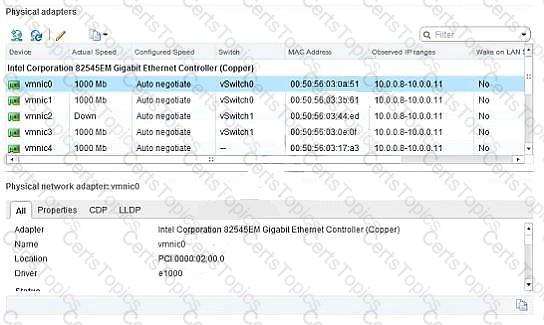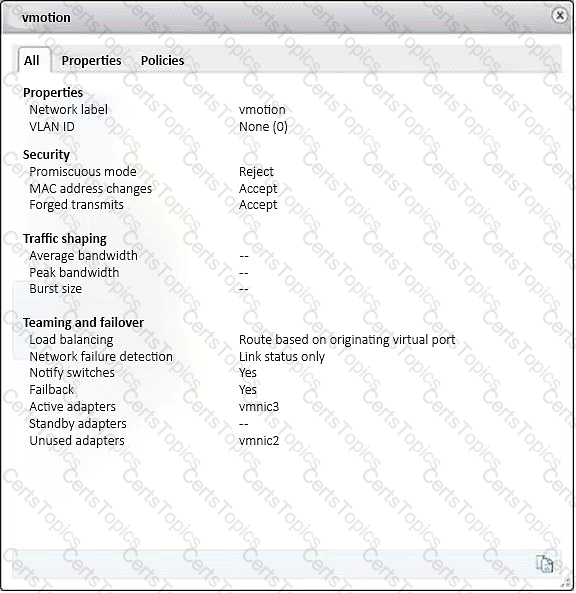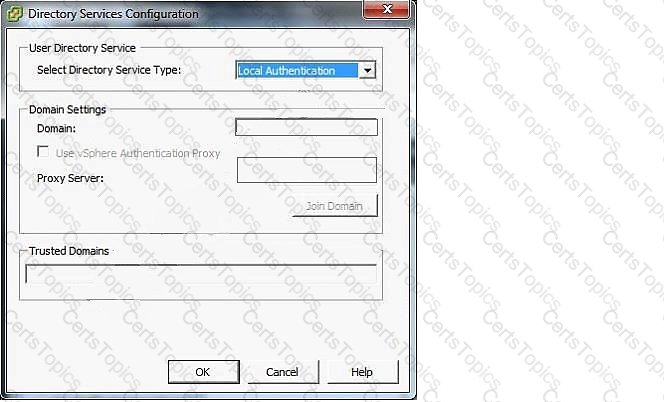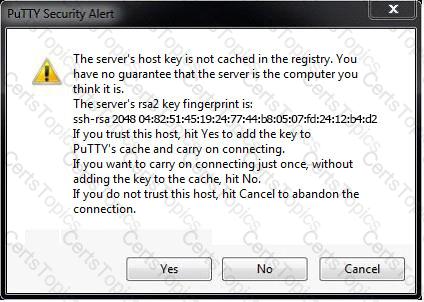Where would a VMware vsphere 6.x Administrator go to view the detailed health of the vCenter server Appliance (vCSA)?
What are two ways to identify TCP/IP stack information? (Choose two.)
Which three vSphere 6.x features require a shared storage infrastructure to work properly? (Choose three.)
Which two High Availability (HA) Cluster admission control policies can help avoid resource fragmentation? (Choose two.)
Which type of network traffic is used for vSphere High Availability (HA) by default?
An administrator logs into the vSphere Web Client, but is unable to see any hosts and clusters.
Which two options could fix the problem? (Choose two.)
An administrator is attempting to power on a virtual machine, but the task is hanging at 95%.
What three scenarios best explain why this problem is happening? (Choose three.)
A developer needs to create a multi-tier development stack for a home lab.
Which vSphere product will support the architecture required for the least software cost?
An administrator is only able to see the Health Badge when using the vRealize Operations user interface.
What is the likely cause of this behavior?
A vSphere Administrator has a VM in an environment configured with 2 vCPU and 4 GB memory, and the VMware administrator has configured it with 2 GB memory reservation.
When the virtual machine is powered on, what size will the VM's swap file be?
Which three conditions would prevent Storage I/O Control from being enabled on a group of datastores? (Choose three.)
An application running in a virtual machine is experiencing performance issues. When utilizing performance monitoring utilities, it is noted that the CPU Utilization of the application is at 100%.
Which two scenarios are probable causes of the CPU contention for the application? (Choose two.)
Refer to the Exhibit. An administrator is configuring an ESXi 6.x host to use multiple NICs to resolve a management network redundancy error. After configuring a second NIC, the server is not able to communicate when the primary connection is taken down.
The administrator analyzes the Exhibit shown here.

Based on the exhibit, what is the likely cause of the issue?
In a vSphere environment, a VM is configured as follows:

What is the default size of the VM swap file once the VM is powered on?
What is required when changing a virtual machine name using the vSphere Web Client?
An administrator is using the Host Failures to Tolerate Admission Control Policy for a vSphere High Availability (HA) cluster. When configuring this setting on the cluster, the administrator sees this error message:
Insufficient resources to satisfy HA failover level on cluster
What are two likely causes for the error? (Choose two.)
An administrator configures vSphere Replication for a virtual machine and enables multiple point in time (PIT) instances under the recovery settings in the Configure Replication wizard.
Which two statements are correct for vSphere Replication with multiple point in time instances enabled? (Choose two.)
A vSphere administrator needs to backup a virtual machine that has a Microsoft SQL Server Database installed.
Which solution allows for an application quiesce to occur during backup?
What two object types can be created inside of vApp? (Choose two.)
Refer to the Exhibit.
An administrator has been given requirements to configure vMotion for a new virtual machine. The configuration should:
Provide Network Redundancy
Use VLAN 550
Be secured against anyone trying to spoof communication
The vSwitch1 configuration is shown in the Exhibit.

Which three changes should be made to meet the stated requirements? (Choose three.)
When configuring vSphere Replication for a virtual machine, what is the lowest Recovery Point Objective (RPO) that can be selected?
An administrator has configured an alarm to be notified when a virtual machine meets two conditions:
high virtual CPU
high active memory consumption
The alarm is malfunctioning and triggering when either condition is met instead of both.
What can be done to correct the issue?
When attempting to power on a Virtual Machine you observe the following error:
Cannot open the disk '/vmfs/volumes/volume/vm/vm-000002.vmdk' or one of the snapshot disks it depends on.
Which three actions will be the best solutions to address this problem? (Choose three.)
The vSphere administrator is configuring directory services for an ESXi host:

What should the vSphere administrator do to configure the host to use CAM services?
An administrator is moving a virtual machine into a resource pool. The VM and resource pool are configured as shown:
VM configuration:
2GHz CPU reservation
1GB Memory limit
Resource Pool configuration:
6GHz CPU reservation
1GB Memory reservation
No limit to memory
What happens to the virtual machine's resource settings when it is moved into the pool?
A vSphere administrator has been using vSphere in evaluation mode and now wants to deploy an environment that provides the same features.
Which edition of vSphere provides similar functionality to evaluation mode?
An administrator is migrating a virtual machine from a Test cluster to a Production cluster.
The two environments do not have any shared storage.
What is the easiest way to accomplish this task?
Refer to the Exhibit. An administrator has configured network connectivity for a new virtual machine, as shown in the Exhibit.

What will occur with the network traffic of this virtual machine when communicating externally from vSwitch1?
From which two locations in the inventory hierarchy can you deploy a virtual machine using a template? (Choose two.)
Which two configurable options apply to both virtual machine CPU and memory allocation? (Choose two.)
An administrator creates an ESXi cluster using vSphere Auto Deploy. The ESXi hosts are configured to get a management IP address from a DHCP server. The administrator needs to troubleshoot the management network on one of the hosts. Which DCUI option should the administrator use to renew the DHCP lease?
A new vApp was built and tested in the corporate headquarters datacenter running vSphere 6.x.
What condition would explain why the virtual machine is failing to boot in an offsite datacenter running on vSphere 5.5?
The vSphere administrator attempts to connect to an ESXi host via an SSH client and receives the following security alert:

The vSphere administrator needs to determine whether the RSA key fingerprint shown in the security alert is the fingerprint of the intended ESXi host.
Which tool should the vSphere administrator use?
A company has decided to implement Virtual SAN within their vSphere 6.x environment.
The Virtual SAN cluster will be composed of three ESXi 6.x hosts that are on the Virtual SAN Ready Node list.
Each ESXi host includes:
The company will pilot a Virtual SAN cluster utilizing VMware best practices while maximizing storage capacity. The Virtual SAN cluster will use Manual Mode.
Which two Disk Group configurations would meet the stated configuration requirements? (Choose two.)
An administrator deploys vCenter Server using the embedded Platform Services Controller.
After testing the deployment for a couple of months, it is determined that the environment would be better served with an external Platform Services Controller.
What should the administrator do to meet this new requirement?
After selecting an object in vRealize Operations, how can a user compare the badge values of related child objects?
An administrator is configuring the Failover Order option on a vSphere Distributed Switch.
Which two options should be used with IP-hash load balancing? (Choose two.)
A vSphere Administrator wants to migrate a virtual machine from a host with an AMD Opteron CPU to an intel Xeon CPU.
Which method should be used?
Which is a valid requirement for deploying the vCenter Server Appliance 6.x to a DRS cluster?
Which of the following are valid iSCSI adapter types for vSphere? (Choose three.)
What are two uses of the vRealize Log Insight Agents for Windows and Linux? (Choose two.)
Which two options are available when migrating a powered off VM and relocating the attached disks? (Choose two.)
What is the maximum supported RAM per virtual machine (VM) in vSphere 6.5?
What two options are available when configuring a virtual flash resource on a virtual machine? (Choose two.)
What is the VMware recommended way to distribute storage I/O loads across multiple paths to minimize downtime and remove potential bottlenecks?
A vSphere Administrator sees the alarm:
vSphere HA virtual machine failed to failover
This occurred for a number of virtual machines on a particular ESXi host in a cluster with vSphere High Availability (HA) enabled. The virtual machines guest operating systems never reported a power event.
What happened?
Which two databases are supported for the vCenter Server Appliance 6.x? (Choose two.)
A vSphere Administrator recently upgraded to vSphere .6.5 and wants to assign more than 4 TB of RAM to the virtual machine.
What must happen first?
Which two options can be leveraged to configure a remote syslog server for an ESXi 6.x host? (Choose two.)
A VMware vSphere 6.x Administrator is implementing a new eight-node cluster for business critical applications. Each server will be configured with two 10 GbE network adapters and will utilize iSCSI for storage on one subnet.
Which feature is required to implement this solution?
Which two statements are correct when licensing an ESXi 6.x host? (Choose two.)
ESXi 6.x can be installed upon which three supported hardware configurations? (Choose three.)
After reconfiguring VUM in the vCenter Server Appliance, a vSphere Administrator must restart the Update Manager service.
Which VMware recommended action will let the Administrator accomplish this task?
What are the correct steps to migrate the storage of a virtual machine?
Which three IP addresses may be pinged by the Test Management Network feature in the ESXi hosts DCUI? (Choose three.)
One of your virtual machines (VM) has performance issues and sometimes in unresponsive.
Which VM file must be checked in order to find the root cause?
The Triggered Alarm on the VM shows Virtual Machine Consolidation needed status.
How would an administrator recover from this event?